Analysis of the Degradation of Pearlitic Steel Mechanical Properties Depending on the Stability of the Structural Phases
Abstract
:1. Introduction
2. Materials and Methods
2.1. Testing System
2.2. Sample Heating
3. Results and Discussion
3.1. Heating Time
3.2. Analysis of the Phase Transformations Using AE
3.3. Change in Hardness as a Function of the Austenitisation Time
4. Conclusions
Author Contributions
Funding
Institutional Review Board Statement
Informed Consent Statement
Data Availability Statement
Conflicts of Interest
References
- Napoli, G.; Fabrizi, G.; Rufini, R. Effect of Quenching and tempering process on a medium C steel with low chromium and molybdenum addition for forged components. Acta Metall. Slovaca 2018, 24, 112–118. [Google Scholar] [CrossRef] [Green Version]
- Haiko, O.; Kaijalainen, A.; Hannula, J. The effect of tempering on the microstructure and mechanical properties of a novel 0.4C press-hardening steel: A model describing TRIP and TWIP effects. Appl. Sci. 2019, 9, 4231. [Google Scholar] [CrossRef] [Green Version]
- Wegrzyn, T.; Hadrys, D.; Miros, M. Optimization of operational properties of steel welded structures. Eksploat. Niezawodn. Maint. Reliab. 2007, 3, 30–33. [Google Scholar]
- Kovačič, M.; Lešer, B.; Brezocnik, M. Modelling and optimization of sulfur addition during 70MnVS4 steelmaking: An industrial case study. Adv. Prod. Eng. Manag. 2021, 16, 253–261. [Google Scholar] [CrossRef]
- Zhang, P.; Wang, D.; Cheng, P. Microstructure, mechanical properties and corrosion behavior of 65Mn tape-steel via electromagnetic induction heating. Mater. Today Commun. 2022, 30, 103175. [Google Scholar] [CrossRef]
- Galindo-Nava, E.; Rivera-Díaz-del-Castillo, P.E.J. Understanding martensite and twin formation in austenitic steels: A model describing TRIP and TWIP effects. Acta Mater. 2017, 128, 120–134. [Google Scholar] [CrossRef] [Green Version]
- Kumbár, V.; Votava, J. Differences in engine oil degradation in spark-ignition and compression-ignition engine. Eksploat. Niezawodn. Maint. Reliab. 2014, 16, 622–628. [Google Scholar]
- Lu, X.; Li, S.; Jiang, X. Effects of σ phase in stainless steels on corrosive wear behavior in sulfuric acid. Wear 2001, 251, 1234–1238. [Google Scholar] [CrossRef]
- Moradian, Z.; Li, B.Q. Hit-Based Acoustic Emission Monitoring of Rock Fractures: Challenges and Solutions. In Advances in Acoustic Emission Technology; Springer: Cham, Switzerland, 2017; pp. 357–370. [Google Scholar]
- Haušild, P.; Nohava, J.; Pilvin, P. Characterisation of strain-induced martensite in a metastable austenitic stainless steel by nanoindentation. Stat. Anal. Mach. Learn. 2011, 47, 129–133. [Google Scholar] [CrossRef]
- Łazarska, M.; Wozniak, T.; Ranachowski, Z. The Use of Acoustic Emission and Neural Network in the Study of Phase Transformation below MS. Materials 2021, 14, 551. [Google Scholar] [CrossRef]
- Zavdoveev, A.; Poznyakov, V.; Baudin, T. Effect of heat treatment on the mechanical properties and microstructure of HSLA steels processed by various technologies. Mater. Today Commun. 2021, 28, 102598. [Google Scholar] [CrossRef]
- Trafarski, A.; Lazarska, M.; Ranachowski, Z. Application of acoustic emission to the analysis of phase transformations in 27MnCrB5-2 steel tests during continuous cooling. Bull. Pol. Acad. Sci. Tech. Sci. 2021, 69, 139389. [Google Scholar]
- Lehnert, R.; Franke, A.; Biermann, H. Acoustic emission measurements on metastable austenitic steel oligocrystals. Mater. Sci. Eng. A 2021, 827, 142066. [Google Scholar] [CrossRef]
- Chen, Y.; Gou, B.; Ding, X. Real-time monitoring dislocations, martensitic transformations and detwinning in stainless steel: Statistical analysis and machine learning. Metall. Mater. Trans. 2021, 92, 31–39. [Google Scholar] [CrossRef]
- Bolgár, M.; Nagy, E.; Daróczi, L. Acoustic Emission During Austenite → ε Martensitic Phase Transformation in TWIP/TRIP Steels. Metall. Mater. Trans. A 2019, 50, 3495–3501. [Google Scholar] [CrossRef] [Green Version]
- Ahmed, J.; Zhang, T.; Ozevin, D. A multiscale indentation-based technique to correlate acoustic emission with deformation mechanisms in complex alloys. Mater. Charact. 2021, 182, 111575. [Google Scholar] [CrossRef]
- Paeg, D.; Jong, C. Investigation of carbide precipitations on microstructure and hardness of medium carbon Cr-Ni austenite stainless hardfacing deposit with high wear resistance properties. Weld. World 2022, 66, 1111–1119. [Google Scholar]
- Votava, J.; Jukl, M.; Polcar, A. Anti-corrosion systems in vehicles for the transportation and application of fertilizers. Kov. Mater. Met. Mater. 2018, 56, 131–136. [Google Scholar] [CrossRef] [Green Version]
- ČSN EN ISO 6508-1; Metallic Materials, Rockwell Hardness Test, Part 1. ÚNMZ: Prague, Czech Republic, 2018.
- Votava, J.; Luptáková, N.; Kumbár, V. Hard-metal spray application on blade segment of sugar beet harvester cutting units. Sugar Sugar Beet J. 2015, 131, 341–346. [Google Scholar]
- Votava, J.; Fajman, M.; Polcar, A. Using hard-metal deposits in sugar beet harvesters. Sugar Sugar Beet J. 2019, 135, 297–302. [Google Scholar]
- Šmak, R.; Votava, J.; Polcar, A. The Cooling Media Influence on Selected Mechanical Properties of Steel. Acta Technol. Agric. 2020, 23, 183–189. [Google Scholar] [CrossRef]
- Zaleski, K. The effect of vibratory and rotational shot peening and wear on fatigue life of steel. Eksploat. Niezawodn. Maint. Reliab. 2017, 19, 102–107. [Google Scholar] [CrossRef]
- Meloun, M.; Militký, J. Compendium of Statistical Data Processing, 3rd ed.; Karolinum: Prague, Czech Republic, 2012; ISBN 978-80-246-2196-8. [Google Scholar]
- Meloun, M.; Militký, J. Statistical Data Analysis; Woodhead: New Delhi, India, 2011; p. 1600. ISBN 978-93-80308-11-1. [Google Scholar]
- Weresa, E.; Seweryn, A.; Szusta, J.; Rak, Z. Fatigue testing of transmission gear. Eksploat. Niezawodn. Maint. Reliab. 2015, 17, 207–214. [Google Scholar] [CrossRef]


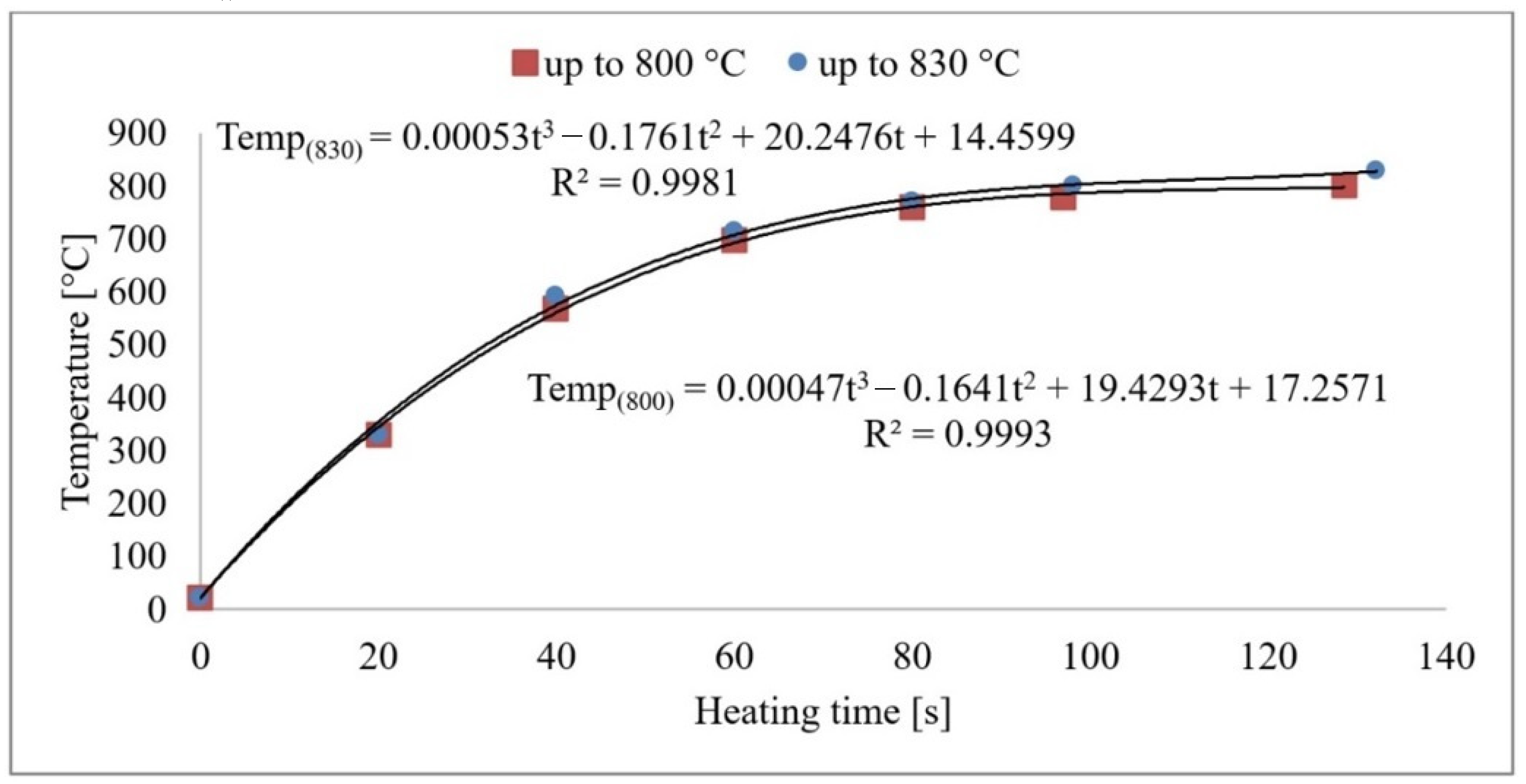


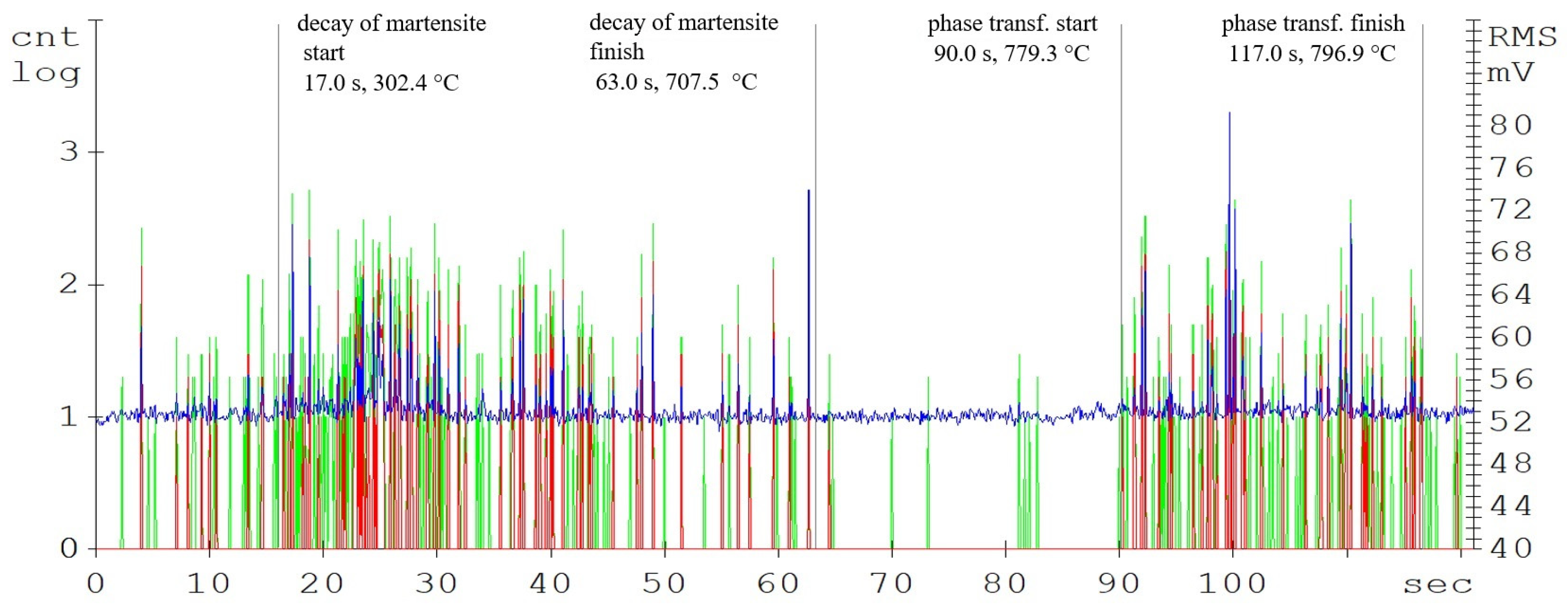
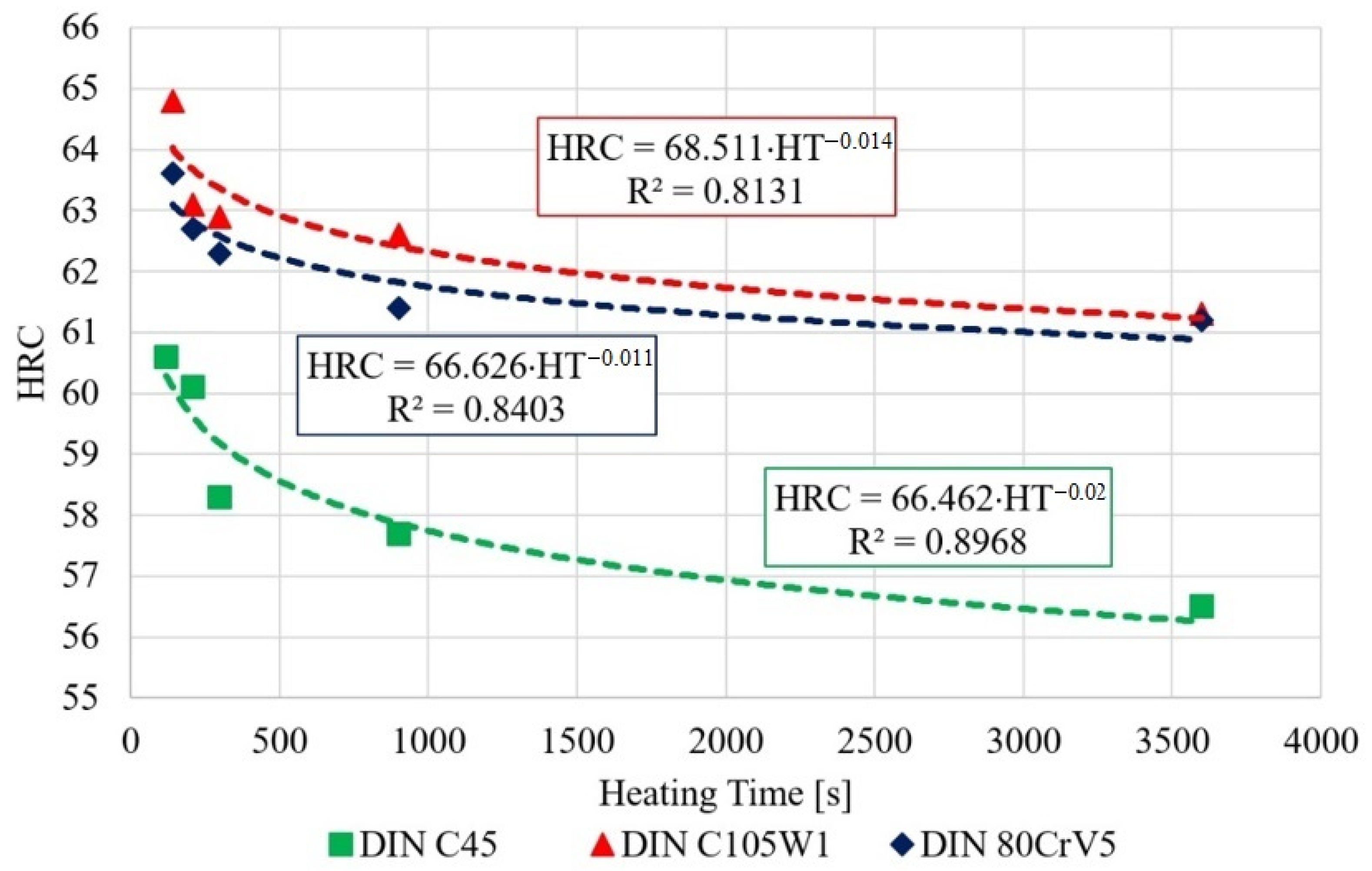
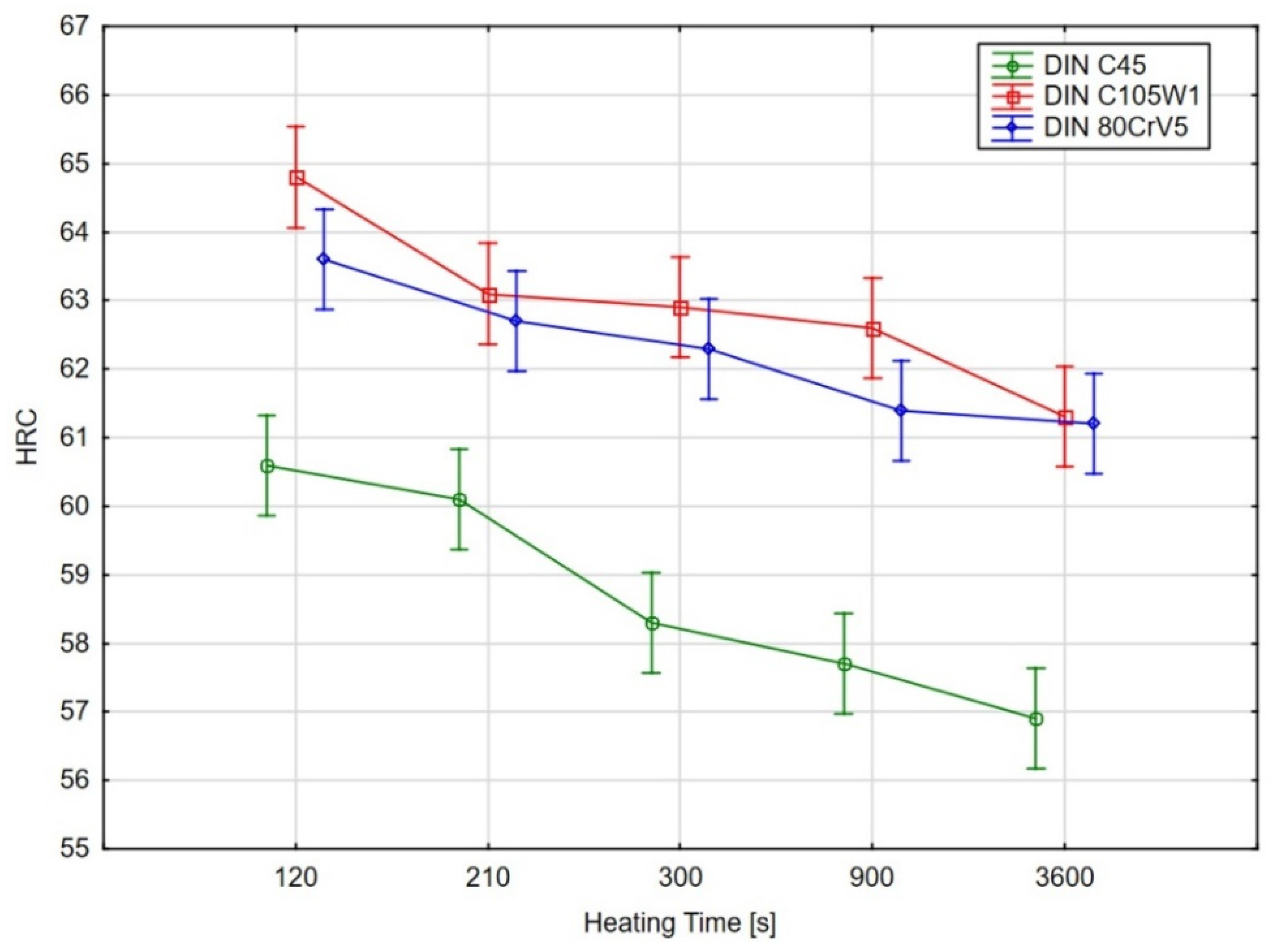
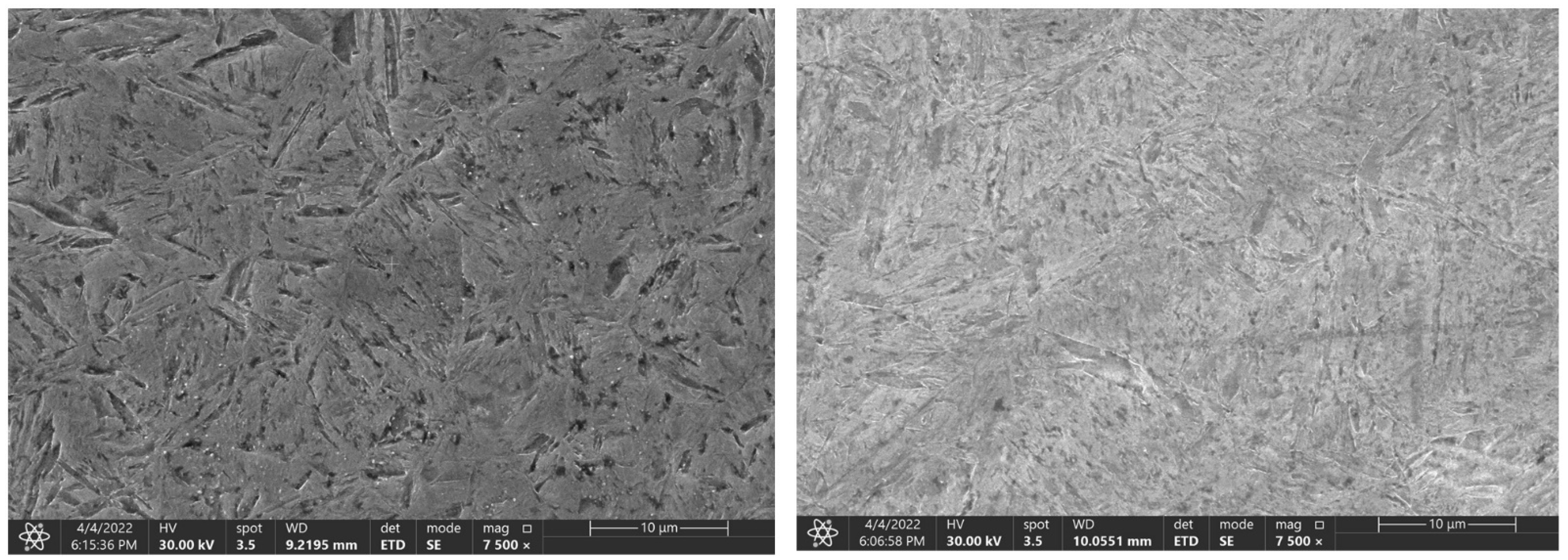
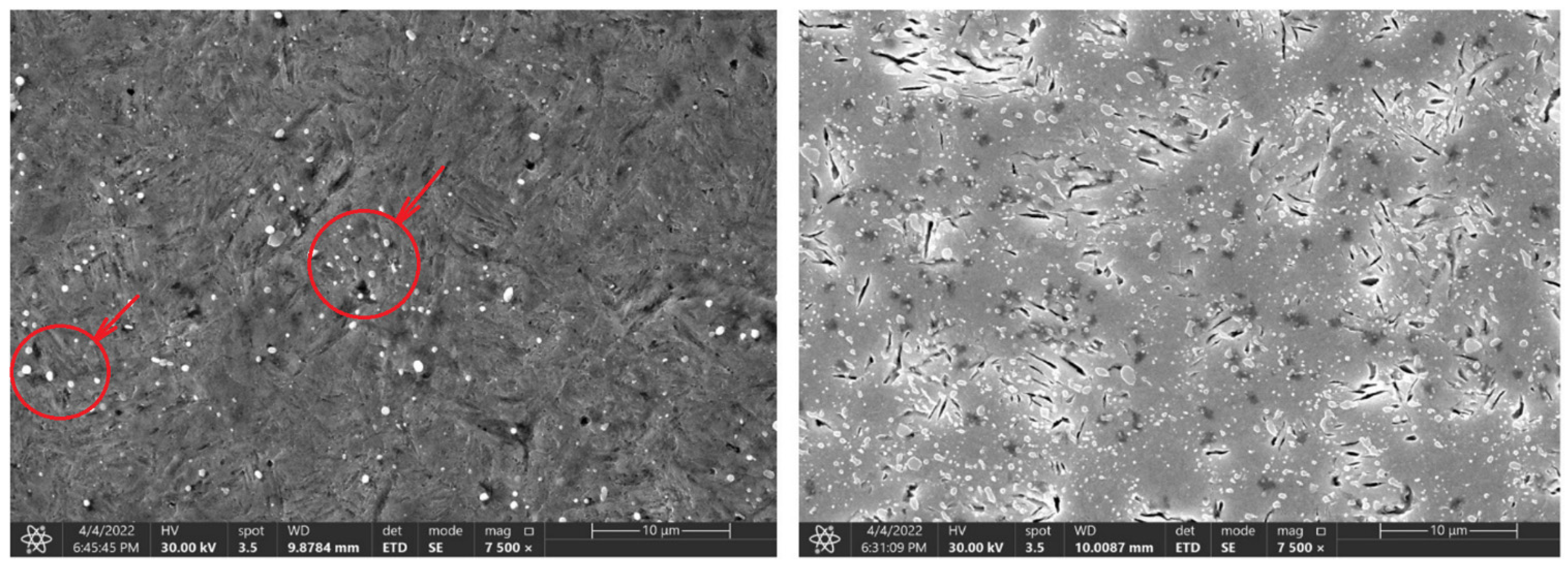
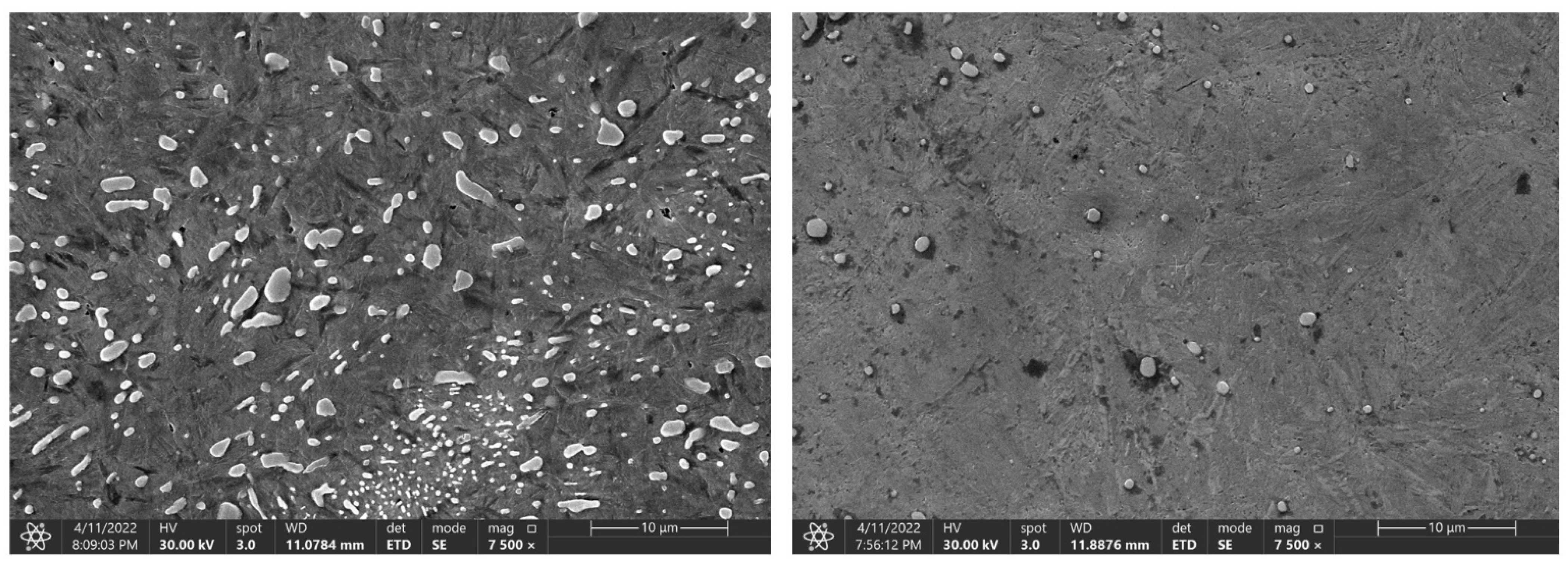
| C45 | |||||
|---|---|---|---|---|---|
| C, wt. % Standard/Measured | Mn, wt. % Standard/Measured | Si, wt. % Standard/Measured | P, wt. % Standard/Measured | S, wt. % Standard/Measured | Cr, wt. % Standard/Measured |
| 0.40–0.50/0.60 | 0.60–0.80/1.40 | 0.15–0.40/0.40 | max. 0.35/- | max. 0.35/- | - |
| C105W1 | |||||
| C, wt. % Standard/measured | Mn, wt. % Standard/measured | Si, wt. % Standard/measured | P, wt. % Standard/measured | S, wt. % Standard/measured | Cr, wt. % Standard/measured |
| 0.95–1.09/0.90 | 0.20–0.35/0.40 | 0.15–0.30/0.50 | max. 0.025/- | max. 0.30/- | max. 0.15/- |
| 80CrV5 | |||||
| C, wt. % Standard/measured | Mn, wt. % Standard/measured | Si, wt. % Standard/measured | P, wt. % Standard/measured | S, wt. % Standard/measured | Cr, wt. % Standard/measured |
| 0.75–0.85/0.70 | 0.30–0.50/0.70 | 0.20–0.40/0.80 | max. 0.030/- | max. 0.030/- | 0.45–0.65/0.60 |
| Steel | Decomposition of Martensite | Austenitisation | ||||||
|---|---|---|---|---|---|---|---|---|
| Time, s | Temperature, °C | Time, s | Temperature, °C | |||||
| from | to | from | to | from | to | from | to | |
| C45 | 8.0 | 47.0 | 165.4 | 632.1 | 93.0 | 133.0 | 800.7 | 839.2 |
| C105W1 | 4.0 | 64.0 | 92.4 | 711.8 | 86.0 | 119.0 | 733.4 | 797.5 |
| 80CrV5 | 17.0 | 63.0 | 302.4 | 707.5 | 90.0 | 117.0 | 779.3 | 796.9 |
| C45 | C105W1 | 80CrV5 | |||||||
|---|---|---|---|---|---|---|---|---|---|
| HT, s | Avg. MH, HRC | SD, HRC | VC, HRC | Avg. MH, HRC | SD, HRC | VC, HRC | Avg. MH, HRC | SD, HRC | VC, HRC |
| 140 | 60.60 | 0.84 | 0.91 | 64.80 | 0.16 | 0.40 | 63.60 | 1.04 | 1.01 |
| 210 | 60.10 | 0.89 | 0.94 | 63.10 | 0.69 | 0.83 | 62.70 | 1.01 | 1.01 |
| 300 | 58.30 | 3.61 | 1.90 | 62.90 | 3.09 | 1.75 | 62.30 | 0.41 | 0.64 |
| 900 | 57.70 | 1.81 | 1.34 | 62.60 | 0.64 | 0.80 | 61.40 | 0.84 | 0.91 |
| 3600 | 56.90 | 1.29 | 1.13 | 61.30 | 0.81 | 0.90 | 61.20 | 1.36 | 1.16 |
| Heating Time, s | Steel | HRC | Groups | ||||||
|---|---|---|---|---|---|---|---|---|---|
| 3600 | C45 | 56.9 | a | ||||||
| 900 | C45 | 57.7 | a | ||||||
| 300 | C45 | 58.3 | a | ||||||
| 210 | C45 | 60.1 | b | ||||||
| 140 | C45 | 60.6 | b | c | |||||
| 3600 | 80CrV5 | 61.2 | b | c | d | ||||
| 3600 | C105W1 | 61.3 | b | c | d | ||||
| 900 | 80CrV5 | 61.4 | b | c | d | e | |||
| 300 | 80CrV5 | 62.3 | c | d | e | f | |||
| 900 | C105W1 | 62.6 | d | e | f | ||||
| 210 | 80CrV5 | 62.7 | d | e | f | ||||
| 300 | C105W1 | 62.9 | d | e | f | ||||
| 210 | C105W1 | 63.1 | e | f | g | ||||
| 140 | 80CrV5 | 63.6 | f | g | |||||
| 140 | C105W1 | 64.8 | g | ||||||
Disclaimer/Publisher’s Note: The statements, opinions and data contained in all publications are solely those of the individual author(s) and contributor(s) and not of MDPI and/or the editor(s). MDPI and/or the editor(s) disclaim responsibility for any injury to people or property resulting from any ideas, methods, instructions or products referred to in the content. |
© 2023 by the authors. Licensee MDPI, Basel, Switzerland. This article is an open access article distributed under the terms and conditions of the Creative Commons Attribution (CC BY) license (https://creativecommons.org/licenses/by/4.0/).
Share and Cite
Šmak, R.; Votava, J.; Lozrt, J.; Kumbár, V.; Binar, T.; Polcar, A. Analysis of the Degradation of Pearlitic Steel Mechanical Properties Depending on the Stability of the Structural Phases. Materials 2023, 16, 518. https://doi.org/10.3390/ma16020518
Šmak R, Votava J, Lozrt J, Kumbár V, Binar T, Polcar A. Analysis of the Degradation of Pearlitic Steel Mechanical Properties Depending on the Stability of the Structural Phases. Materials. 2023; 16(2):518. https://doi.org/10.3390/ma16020518
Chicago/Turabian StyleŠmak, Radim, Jiří Votava, Jaroslav Lozrt, Vojtěch Kumbár, Tomáš Binar, and Adam Polcar. 2023. "Analysis of the Degradation of Pearlitic Steel Mechanical Properties Depending on the Stability of the Structural Phases" Materials 16, no. 2: 518. https://doi.org/10.3390/ma16020518
APA StyleŠmak, R., Votava, J., Lozrt, J., Kumbár, V., Binar, T., & Polcar, A. (2023). Analysis of the Degradation of Pearlitic Steel Mechanical Properties Depending on the Stability of the Structural Phases. Materials, 16(2), 518. https://doi.org/10.3390/ma16020518






